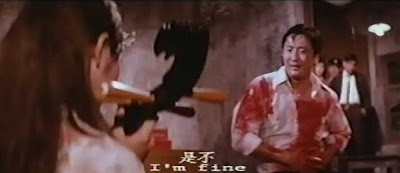The Window

Director: Patrick Lung Kong
Year: 1968
Rating: 6.5
This Hong Kong
Cantonese melodrama from 1968 throws every device known to man at you but
baby twins drowning in a bathtub in an effort to make you cry. To bring out
the Kleenex like munching on popcorn. You can see most of these plot turns
coming at you like a steam locomotive a mile down the track. But much to
my surprise they work – they are effective – it is hard to understand quite
why exactly. I have to give credit to the director and the actors for pulling
a teary-eyed rabbit out of a small hat. The director is Patrick Lung Kong
(who plays the policeman in the film) who in 1968 was one of the very few
bright lights in Cantonese cinema.

The 1960’s were not treating Cantonese
films with much respect. They had been the dominant film form for nearly
all of HK film history – but after the Civil War in China there was a flood
of refugees to Hong Kong – many of them film people who saw the writing on
the walls back home – and they brought with them enormous talent but also
their Mandarin language. And they set up production companies in Hong Kong
that by the 1960’s were bulldozing the Cantonese films into the ground. The
Shaw Brothers and Cathay – both backed by wealthy individuals - were making
films with much higher budgets, longer production cycles, color, better publicity/marketing
machines and a talented in-house group of actors, directors, composers and
so on.

While at the same time Cantonese films
were often pejoratively called weeklies as that is how long they took to
generally make, in black and white and as cheaply made as a cardboard fort
in your backyard. They were sinking and the numbers of films produced were
getting down to desperation levels. Part of the success of the Mandarin films
was their ability to market them to Chinese communities in Taiwan and around
South East Asia – while the Cantonese films primarily were exhibited in Hong
Kong. Now of course China is the big market place and we see homegrown HK
films taking a hit.

Kong though had ambitions and was intent
on putting Cantonese films back on the map – first with Story of a Discharged
Prisoner (which John Woo used as his inspiration for A Better Tomorrow) and
now he shot The Window in color and with a running time of over 100 minutes.
What Cantonese films still had going for them was a group of actors – born
in Hong Kong – who were very popular and Kong uses two of the biggest for
this film. Patrick Tse Yin had been in films since he was a teenager in the
early 1950’s and had become a male heartthrob and also a fine actor – he
is paired opposite Josephine Siao Fong Fong, also a star since a child (part
of the Seven Princesses) in the 1950’s.
The two of them manage to make you accept
a story that on the surface is pretty darn corny and would make a maiden
blush. Of course, his films did not turn around the Cantonese film industry
– that happened in the 1970’s with TV and the Hui Brothers but they helped
keep them alive till then.

Hsia-er (Tse) runs around with two partners
– Niu (Cheung Yee) and the ultra-sexy cleavage advantaged Sophia (Mang Lee,
if a female character had a Western name the odds are they were up to no
good) – committing petty crimes like shoplifting, pickpocketing, snatch and
runs – and not being particularly good at it. Hsia-er is what they called
a Teddy Boy – fashionably dressed, on the bad side, attractive to women,
seemingly immoral and footloose and free. One day he robs an elderly man
of his money and the old man chases after him and is killed in an altercation.
Hsia-er hightails it with the cops after him and hides in a small shanty
home with a woman inside but she doesn’t see him – because she (Josephine)
is blind (perhaps Woo’s inspiration for The Killer).

He gets away but circumstances bring him
back where he realizes that the man he killed is her father – first co-incidence
of many and he is mistaken for her cousin who is coming to take care of her.
This is where the film really departs from reality when we are supposed to
believe that this character who cares for nothing decides to take care of
her because he feels guilty. And after that you can pretty much write the
script – love blossoms – he becomes a new man and she starts jumping from
rock to rock like she has turned into Daredevil – the power of love. But
he killed her father and you know that can’t end well. Or can it?

Josephine is particularly appealing – using
these cloudy contact lenses that make it look as if she has the worst cast
of glaucoma on record. Apparently, the contacts hurt her eyes so much she
had to go into the hospital afterwards. She later said that this film helped
make her feel like an actress as opposed to an idol. She is great. Along
with Discharged Prisoner, this film also solidified Tse as one of Hong Kong’s
legends (his son is of course Nicholas Tse). It is a shame that so few of
these 1960 Cantonese films are available with English subs but this one is
up on YouTube as is Kong’s follow up film Teddy Girls.









